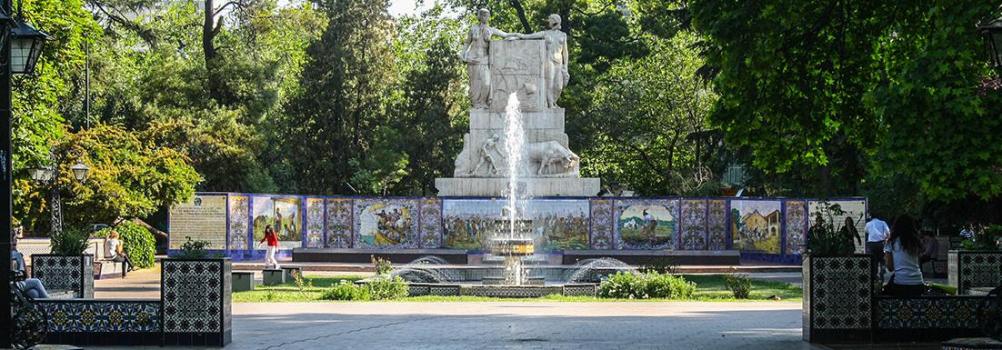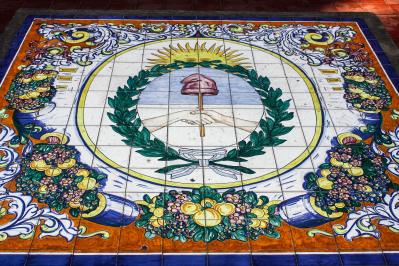
Statues in Plaza Italia honor the Italian immigrants and community who contributed greatly to the region’s wine industry.
I was recovering from eight hours of wine tasting and one outstanding lunch around the Greater Mendoza area, the largest wine-producing region in Latin America, the day before. I lingered over a late and leisurely breakfast at my hotel, the Amérian Executive Mendoza Hotel, and by the time I stepped outside, I had nothing more ambitious in mind than visiting the city’s five famed plazas.
Unlike many other Argentinean cities, trees (100,000 of them) line the streets here, keeping it cool and making it a pleasant place to stroll—provided you remain cognizant of the open, shallow, stone irrigation canals running along the sidewalks that you can easily stumble into. I avoided that mishap when I noticed the little planks and bridges at various intervals along the way that cross over the hazard.
Plaza Italia, one of four plazas all located equidistantly one square block from each corner of the city’s largest plaza, Plaza Independencia (like the pips on a die that rolled up on five), was located directly across the street from my hotel. Its shady pergolas and central fountain drew me in, and although I had walked only about 40′ so far, I decided to sit on one the benches to relax for a bit and absorb the meaning of this plaza and its cousins.
Following an earthquake in 1861 that killed more than 5,000 people, Mendoza rebuilt itself by employing some innovative urban designs that would, in the occurrence of another seismic event, drastically reduce both human and structural losses. Such designs included the widest streets and sidewalks of any city in Argentina as well as these five plazas, which not only beautified the city and pay tribute to its founders but also provide a safe zone to which people could flee to avoid any collapsing buildings.

The colors and star of the flag of Argentina’s neighbor wrap around the base of the fountain in Plaza Chile.
But, on this day, Plaza Italia was solely serving its peaceful purpose, with children romping around the small playground and a few older folk leafing through their daily newspaper. Originally called Plaza Lima, in honor of the Peruvian city’s generous contributions to the earthquake relief efforts, the square was renamed to honor the large Italian community in and around Mendoza. The main sculptural display features a figure representing the Italian motherland, flanked by an Amerindian holding wheat and a Roman philosopher holding a book; coats of arms of Argentina and Italy sheltered by the rays of an Indian sun; a plaque that reads, in Italian, “In honor of all those Italians who contributed with commitment and sacrifice to the greatness of this generous land”; and a couple of bronze reliefs, one of which recognizes the Italians’ contributions to Argentina’s wine industry.
Other statues include the Carrara marble Little Fountain Girl and Fish and the Roman Wolf suckling Remus and his twin brother, Romulus, the founder of Rome. If you’re lucky enough to be here during the annual Fiesta in Piazza, you’ll be able to partake in a three-day celebration of Italian culture and heritage, including performances by opera singers and food stalls selling everything from polenta, pizza, and pasta to tripe and tiramisu.
Four blocks north, I took another little respite in Plaza Chile under the palm and eucalyptus trees. A fountain occupies the center of the plaza, its base ringed with red, white, and blue tiles and single white stars, representing the Chilean flag. Presiding over it all, the stone figures of the Chilean Bernardo O’Higgins and the Argentinean-born José de San Martín—two of South America’s great independence leaders who threw off Spanish rule—stand side by side, their hands resting on a sword. Carved into the base of the statue are the two freedom fighters’ name and countries, topped by the words “AMISTAD INMORTAL” (Immortal Friendship).
Another four blocks away, this time to the east, I parked myself in Plaza San Martín, right in the heart of the city’s banking district and embellished with beautifully arranged flowerbeds. An equestrian statue of the general, seated on his horse as it rises on its hind legs and pointing his finger to the west, alluding to his crossing the Andes to liberate Chile and Peru from Spain after achieving independence for Argentina, dominates the plaza. The enormous base, an irregular stone monolith, sports a variety of randomly placed shields and plaques, including one indicating Mendoza’s height above sea level (2,450′).
Four blocks south, I arrived at what would instantly become my favorite plaza, the gorgeous Plaza España, an artistic reflection of the relationship between Spain and Argentina. Amid the luxuriant trees and shrubs, I was enamored by benches, fountains, planters, and lamppost bases covered with brilliantly colored glossy Andalusian tiles. Beneath me, the corners of each block of four square paving stones were decorated with small glazed Majolica tiles with simple motifs—a castle, perhaps, or a sailing ship or a tropical bird—and I enjoyed discovering new ones as I approached the commanding attraction of the square.
I skirted around the large tile array of bountiful fruits and flowers surrounding the Argentinean coat of arms—a green wreath tied at the bottom by a ribbon of the blue and white of the country’s flag and capped by a rising sun, encircling two shaking hands holding a pike topped by a red Phyrgian cap against a blue and white background. Above me, two female figures—a Spanish noblewoman holding a book and a Mestiza holding a bunch of grapes—stand on either side of a relief of a Spanish sailing ship, which rests on top of a base featuring a relief of a man tilling the soil behind a team of two oxen. The entire arrangement sits atop the central part of a monumental wall divided into panels of vibrantly colored tiles portraying, among other images, Columbus discovering America, the founding of Mendoza, a scene from Don Quixote, and missionary work.
Having completed my circuit of these four satellite plazas, I walked diagonally for one block to the larger and livelier plaza they all orbit. Flanked on one side by the handsome Park Hyatt Mendoza, the 13-acre Plaza Independencia could fit the four other plazas neatly inside it. Passing by an iridescent hummingbird at work, I entered the plaza and made my way to the semicircular dancing fountain, backed by the “Frieze of Independence,” depicting scenes of the indigenous peoples, evangelization, oppression, immigration, and culture, all leading up to independence.
Rare and beautiful trees and plants—as well as a curiously large number of intertwined, lip-locked lovers on benches—are scattered throughout the plaza, which is also the home of the Municipal Museum of Modern Art and a subterranean theater. Street performers and musicians provided free entertainment as I sampled homemade cookies and some yerba maté from the vendors lined up along the plaza’s paths.

Plaza Independencia, the largest square in Mendoza, invites locals and visitors alike to relax in the green lung in the heart of the city.
Dusk had fallen by the time I made my last purchase at the weekend craft market, where artisans sell their handmade wood, jewelry, and textile creations, and a variety of bibelots and crafts made with rhodochrosite, the irresistibly attractive national stone of Argentina, a pink semi-precious stone that’s also called “Inca rose.” Lights in the ornamental lampposts, all painted blue, had flickered on, and the 52′-high coat of arms of the Cuidad de Mendoza—identical to the country’s coat of arms, with the addition of two cornucopias—was ablaze in colorful lights at the edge of the plaza.
Although I had spent one full day outside Mendoza sipping all kinds of reds and whites, and planned to spend the next day outside it again, hiking in Aconcagua Provincial Park, I was glad I sandwiched a day in the city between them. It’s a memorable place, and its plazas only add to the charms of an already winning city.



